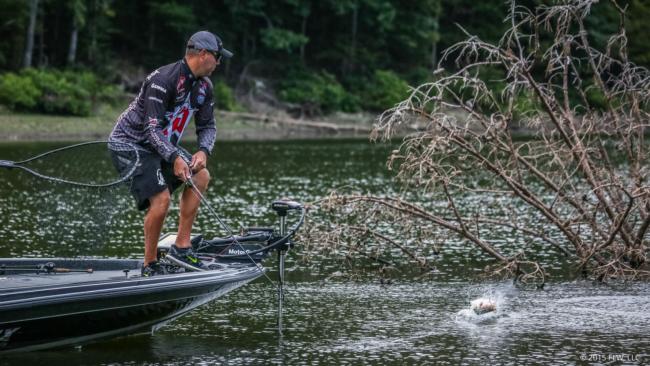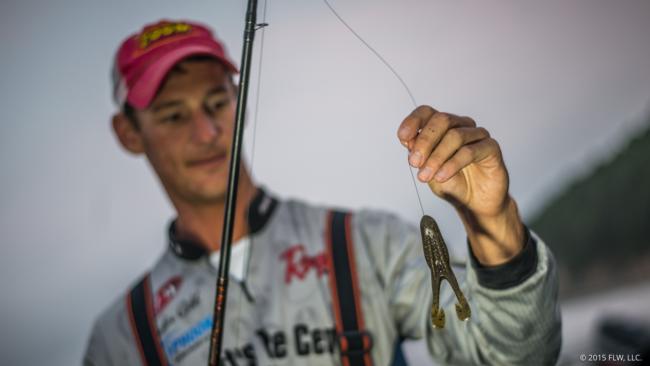2018 Forrest Wood Cup Preview

Lake Ouachita
Hot Springs, Ark.
Aug. 10-12, 2018
Hosted by Arkansas Department of Parks and Tourism and Visit Hot Springs
About the fishery
Home to the 2007, 2011 and 2015 Forrest Wood Cups, Lake Ouachita is a deep, clear mountain reservoir located in western Arkansas within the Ouachita National Forest, a 1.8 million-acre wildlife-rich area that sprawls clear across the Oklahoma border. Construction of the dam took place from the late 1940s to the early 1950s and, depending on the water level, the lake covers about 40,000 surface acres, with approximately 975 miles of shoreline.
Ouachita is a short drive from nearby Hot Springs, Ark., yet due to its location within the Ouachita Mountains and National Forest, there is very little development along its largely remote shoreline.
Standing timber, hydrilla and other grasses, and natural structure such as points and humps provide most of the fishing targets.
Last time
In the three Forrest Wood Cups that have been held on Lake Ouachita, both shallow and deep patterns were applied by top-10 competitors.
Tennessee pro Brad Knight, who won the 2015 Cup on Ouachita, surprised many people by camping in one area in the back of a creek for four days and catching the winning fish shallow. Most folks who target Ouachita’s shallow bass in August opt to run-and-gun around the lake, the assumption being that one spot can’t hold up for several days. Knight, who actually shared his best area with Mark Daniels Jr., proved the naysayers wrong.
The prior two Cups at Ouachita – won by Scott Martin in 2011 and Scott Suggs in 2007 – were won out deep around standing timber, brush piles and other areas where balls of shad had congregated. Martin relied on a drop-shot, Texas-rigged ribbon-tail worm and under-spin. Suggs used a swimbait, worm and spinnerbait.
What to expect this time
According to Suggs and fellow local pro Evan Barnes, Lake Ouachita will still offer up its usual mix of deep and shallow patterns, but there’s a big difference in what we’ll see this time.
“We’ve always had some grass, but this year [by late 2017] we’ve had it over half of the lake,” says Suggs. “The whole entire main lake on the lower half has been totally covered – and all the creeks. It’s hydrilla and milfoil, and some coontail. In the past, normally fish would live suspended and all that, but we’re catching lots of fish back in the grass again.”
The grass sprung up in Ouachita’s lower end due to extremely low water levels and extreme water clarity – caused by a very dry year – and now it’s expanding up the lake. Barnes actually estimates even more total coverage (about 75 percent of the lake) than Suggs. Regardless, both agree there’s more grass in Ouachita than there has been in 10 to 15 years.
Some of the grass will die back over winter, but Suggs believes that unless the water gets extremely dirty for an extended period of time in the spring, there will be plenty of regrowth by August. That means an entirely new set of patterns for Cup competitors.
According to both pros, weights have seen a slight uptick as a result of the grass patterns. Locals were sacking up limits in the upper teens to 20 pounds in late fall and early winter. It probably won’t be that good come August, but there’s a chance the daily average for the winner will crowd 17 pounds. Compared to the 12 pounds and change that Knight averaged in 2015, that’s a marked improvement.
Baits and techniques
How Ouachita’s lower end fishes depends greatly on the grass situation.
“It’ll be right on the verge of topping out at that time. If it does again what it did this year there’s going to be a variety of ways to catch fish,” says Suggs. “There’s been a frog bite, towpater bite and flipping bite, and you can fish up the rivers. It’ll just be kind of a wide-open deal. It won’t be like Lake Murray where it’s a one-dimensional thing. If we get back into the type of summer where the grass doesn’t grow like crazy like it did this summer, then you’re back to catching schooling fish here and there, throwing the Brian’s Bees Prop Bee around the bank and fishing shallow.
“The top half of the lake is going to fish like a whole different world. There’ll be no grass. It’ll be brush, timber, river fishing, dirt shallow, bedding bream – stuff like that. That’s the thing about this lake: Whatever a person’s strength is, whether it’s shallow or way up the river or they like grass, they’re going to have the opportunity to fish whatever kind of fishing they want.”
Barnes agrees with Suggs’ assessment.
“To me, what’s going to happen is you’re still going to see the brush pile bite and schooling fish,” he says. “The fish in the timber – you’re still going to see that. You’re also going to see the bream bed deal. You’re going to have shallow fish for sure, especially in the midsection to the west, where you don’t have as much grass. But to the east, there’s going to be a grass bite, and I think it’s going to be a flipping deal.”
3 critical factors
1. Grass – Obviously, this is a big one. The extent of the grass growth will have a huge impact on the predominant patterns fished throughout the lower end of the lake. It also will dictate which pros feel right at home and which ones are a little lost, as the experience level fishing deep grass lakes varies widely among pros on Tour. One catch when grass fishing in vast amounts of the green stuff is that it can take a very long time to locate fish. That’ll factor into pros’ pre-practice and practice strategies.
2. The bank bite – It’s tough to ignore the shallow bank bite on Ouachita, given the lake’s history of producing some big bags along shore in late summer. And with the Cup only three days long again this year, the shallow pattern stands an even bigger chance of contending for the win. If the grass is thick and it draws typical shallow-focused pros away from the bank, that might open up even more opportunities to catch big bags around bream beds and shallow wood, as resourceful pros take advantage of overlooked bank bass while their competitors play in the green stuff elsewhere.
3. The heat – Near-triple-digit temperatures and swampy humidity are possible at Ouachita, and if those are the conditions pros get when the Cup kicks off, expect this one to be the typical late-summer marathon grind that the Cup so often is.
Fantasy Fishing picks
Because of the potential for new conditions at Ouachita, any “locals” that qualify have a leg up. Scott Suggs and Evan Barnes are definitely favorites if they get in. Scott Martin has won there before and came close a second time. He also has family ties to the Ouachita area, so he considers it a home away from home. Otherwise, John Cox knows shallow bass and grass fishing better than most, so watch out for him, as well as anyone from Texas (Jeff Sprague, Clark Wendlandt, etc.) with experience on grassy reservoirs in hot conditions.

